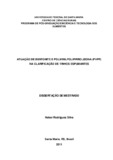| dc.creator | Silva, Heber Rodrigues | |
| dc.date.accessioned | 2011-12-13 | |
| dc.date.available | 2011-12-13 | |
| dc.date.issued | 2011-04-14 | |
| dc.identifier.citation | SILVA, Heber Rodrigues. PERFORMANCE OF BENTONITE AND POLYVINYLPOLYPYRROLIDONE (PVPP) IN THE CLARIFICATION OF SPARKLING WINE. 2011. 67 f. Dissertação (Mestrado em Ciência e Tecnologia dos Alimentos) - Universidade Federal de Santa Maria, Santa Maria, 2011. | por |
| dc.identifier.uri | http://repositorio.ufsm.br/handle/1/5704 | |
| dc.description.abstract | The size and persistence of the bubbles is one of the characteristics pursued by consumers of sparkling wine. The perlage is closely linked to nitrogen products, usually proteins of low molecular weight. Furthermore, bentonite and polyvinylpolypyrrolidone (PVPP) are glues used both in cleaning up the base wine and the sparkling wines, in other words, the fermentation in bottles, and can even drag from the liquid the phenolic compounds. The aim of this study was to evaluate the action of these two clarifiers upon the perlage, a synonym for this type of wine quality. So sparkling wines were prepared, using nine treatments and three replications; the amount of polyvinylpolypyrrolidone and bentonite varied in each treatment and also a blank was made. It was analyzed total nitrogen, through Micro-Kjedahl, carbon dioxide, total phenols, oxygen, time that perlage lasts and some other classical physical-chemistry compounds. It was found that polyvinylpolypyrrolidone and bentonite additions were crucial to control turbidity of the sparkling wines; it was noted a decrease in total nitrogen when using increasing of both clarifiers. The treatments with polyvinylpolypyrrolidone alone reduced more the amounts of phenolic compounds when compared with those treated only with bentonite. This fait confirmed a higuer bounding between polyvinylpolypyrrolidone and phenols than between bentonite and phenols. The clarification reduced the time that perlage lasted in a direct relationship with the decrease of total nitrogen. Some treatments did not show a relation between carbon dioxide and perlage; perhaps the temperature that the sparkling wine was poured in the cup, the difference among the glass walls of the different cups or yet, the residues in the glass (from soap etc.) caused different sites of nucleation. | eng |
| dc.description.sponsorship | Coordenação de Aperfeiçoamento de Pessoal de Nível Superior | |
| dc.format | application/pdf | por |
| dc.language | por | por |
| dc.publisher | Universidade Federal de Santa Maria | por |
| dc.rights | Acesso Aberto | por |
| dc.subject | Nitrogênio | por |
| dc.subject | Perlage | por |
| dc.subject | Proteínas | por |
| dc.subject | Turbidez | por |
| dc.subject | Espuma | por |
| dc.subject | Nitrogen | eng |
| dc.subject | Perlage | eng |
| dc.subject | Protein | eng |
| dc.subject | Turbidity foam | eng |
| dc.title | Atuação de bentonite e polivinilpolipirrolidona (PVPP) na clarificação de vinhos espumantes | por |
| dc.title.alternative | Performance of bentonite and polyvinylpolypyrrolidone (PVPP) in the clarification of sparkling wine | eng |
| dc.type | Dissertação | por |
| dc.description.resumo | O tamanho e persistência das bolhas é uma das características buscadas pelos consumidores de vinhos espumantes. Esta perlage está intimamente ligada a produtos nitrogenados, geralmente proteínas de baixo peso molecular. Por outro lado, bentonite e polivinilpolipirrolidona (PVPP) são colas usadas tanto na limpeza do vinho base quanto na limpeza do vinho espumante propriamente dito, ou seja, na fermentação em garrafas, podendo ainda, arrastar compostos fenólicos do meio. O intuito desta pesquisa foi avaliar a ação destes dois clarificantes frente à perlage, sinônimo de qualidade deste tipo de vinho. Para isto foram elaborados vinhos espumantes, constituindo 9 tratamentos e 3 repetições, onde foram variadas as quantidades de cada clarificante, interagindo ou não em um mesmo tratamento, havendo ainda um tratamento controle sem a adição de ambos clarificantes. Foi efetuado um estudo da quantificação de nitrogênio total, através do método Micro-Kjedahl, análise de dióxido de carbono, compostos fenólicos totais, oxigênio, tempo de perlage e algumas análises físico-químicas clássicas que caracterizaram o produto. Notou-se que a adição de bentonite e polivinilpolipirrolidona foi primordial para controlar o processo de turvação dos espumantes, pois, verificou-se uma diminuição do teor de nitrogênio total a partir do aumento das doses das colas. Observou-se também que, os tratamentos com adição de polivinilpolipirrolidona reduziram o teor de compostos fenólicos totais em comparação aos que foram adicionados somente com bentonite, confirmando a capacidade de ligação mais íntima entre polivinilpolipirrolidona e fenóis que bentonite e fenóis. A clarificação reduziu o tempo de perlage em relação direta à diminuição da quantidade de nitrogênio total dos tratamentos. Em relação ao dióxido de carbono, notou-se que, em alguns tratamentos não ocorreu uma correlação entre a concentração de dióxido de carbono e a perlage. Talvez a temperatura de serviço do líquido, a diferença entre as paredes de vidro das diferenças taças ou restos de resíduos na taça gerado por detergente, tenha ocasionando distintos sítios de nucleação. | por |
| dc.contributor.advisor1 | Daudt, Carlos Eugenio | |
| dc.contributor.advisor1Lattes | http://buscatextual.cnpq.br/buscatextual/visualizacv.do?id=K4787512D2 | por |
| dc.contributor.referee1 | Giovannini, Eduardo | |
| dc.contributor.referee1Lattes | http://buscatextual.cnpq.br/buscatextual/visualizacv.do?id=K4707964U8 | por |
| dc.contributor.referee2 | Londero, Patricia Medianeira Grigoletto | |
| dc.contributor.referee2Lattes | http://buscatextual.cnpq.br/buscatextual/visualizacv.do?id=K4735142Z5 | por |
| dc.creator.Lattes | http://buscatextual.cnpq.br/buscatextual/visualizacv.do?id=K4217495T1 | por |
| dc.publisher.country | BR | por |
| dc.publisher.department | Ciência e Tecnologia dos Alimentos | por |
| dc.publisher.initials | UFSM | por |
| dc.publisher.program | Programa de Pós-Graduação em Ciência e Tecnologia dos Alimentos | por |
| dc.subject.cnpq | CNPQ::CIENCIAS AGRARIAS::CIENCIA E TECNOLOGIA DE ALIMENTOS | por |


